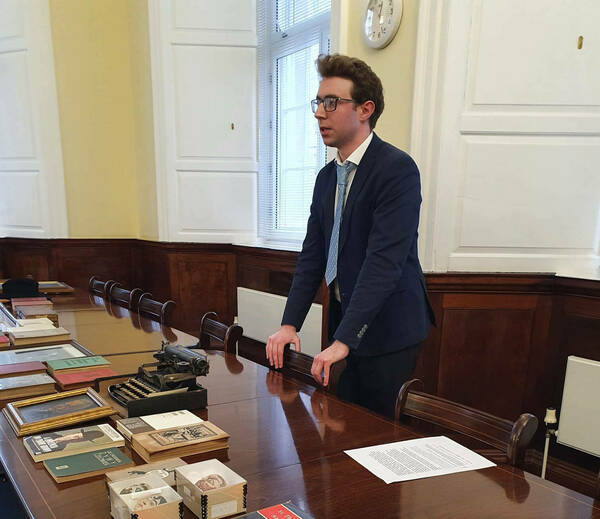
In recent months, Ronan Doheny, an archivist with a background in Modern Irish and Church history, has begun working on the G.K. Chesterton Collection at the Notre Dame London Global Gateway. At the same time Trish Bredar, an academic focusing on British literature of the long nineteenth century, has been working as the Chesterton Postdoctoral Fellow on the Notre Dame main campus. Ronan and Trish are looking at Chesterton through different lenses, but both are discovering him through materials held at Notre Dame. Here, they describe their interactions with the Chesterton Collections on each side of the Atlantic.
Snapshot of Chesterton

‘The most incredible thing about miracles is that they happen.’ As a big Chesterton fan, it was a dream come true to be able to work on the G.K. Chesterton Collection at the Notre Dame London Global Gateway. I was tasked with archiving the artwork, personal items and toy theatres in the collection. This was a most rewarding experience and an honour, ensuring the long term preservation of a great man and possible future saint.
The artwork showcases Chesterton’s whimsical personality with some of the highlights including the earliest known drawing by Chesterton aged about 7 and a beautiful set of three pastel drawings named the ‘Ghosts of Beaconsfield’ where Chesterton humorously depicts himself being haunted by the ghosts of the three most famous former residents of his hometown: the poet Edmund Waller, the statesman Edmund Burke and the British Prime Minister Benjamin Disraeli. Chesterton’s personal items give an excellent snapshot of the man with the collection including items from his deathbed, some of his favourite walking sticks, pens, the typewriter used by his wife Frances and secretary Dorothy Collins to type his manuscripts as well as one of his hats. If Chesterton does become a saint, the collection holds First Class Relics in the form of locks of his hair. This part of archiving the collection was a particular honour as it was vital that these be carefully preserved and stored for the future.
Perhaps the most impressive part of the collection are the toy theatres. The collection holds the toy theatre backgrounds and characters that Chesterton handmade and decorated for his toy theatre shows in his home of Beaconsfield. As Gilbert and Frances were sadly unable to have children of their own, they hosted toy theatre shows for the local children in which Chesterton performed. The backgrounds are a wonderful mix of locations including palaces, mountains and caves. The toy theatre characters are a varied collection that range from pirates to hippos, a king to a baby smoking a cigar. One of the best parts of this section is nearly an entire series of characters from Chesterton’s ‘St. George and the Dragon’ play from 1907. The play ended with a procession of the Champions of Christendom and the collection contains the characters for St. George, St. James, St. Denis, St. Andrew, St. David and St. Patrick.
It was truly a joy to work on this project. Chesterton lived a life full of joy and when coming into contact with his personal items or reading his books, that joy is infectious. Reading his Autobiography while working on the collection it is clear that he was truly grateful for all he had been given in life and all he had received through the Church. Likewise, I am truly grateful for this opportunity to work on the collection of a man who helped grow and inform my belief in Catholicism. One more Chesterton quote before I go, ‘The Bible tells us to love our neighbors, and also to love our enemies; probably because they are generally the same people’.
Chesterton through the Archives

My way of getting to know the celebrated G. K. Chesterton has been unconventional; in fact, I think I can safely say unique. Part of my work as Notre Dame’s Chesterton Postdoctoral Fellow involves delving into Notre Dame’s extensive Chesterton-related collections, which span the University’s South Bend campus and London Global Gateway.
My first encounters in the archive were not with Chesterton himself, but with a group of his devoted followers, The Chestertonians of Notre Dame. The organization, founded by Notre Dame English Professor Rufus William Rauch in 1979, brought together academics and other members of the community for regular discussions of Chesterton’s life and works. Processing the group’s correspondence and administrative records, which are housed in the University of Notre Dame Archives, I was struck by the wealth of correspondence, news articles, fliers, and other ephemera that placed the Chestertonians of Notre Dame within a lively network of Chesterton scholars and enthusiasts from the U.S. and beyond. Of course, these records also highlight Notre Dame’s longstanding Chesterton connections. In 1980, the group hosted a “Chesterton Celebration” to mark the 50th anniversary of Chesterton’s guest lectureship at Notre Dame. Rauch, who had been a junior faculty member at the time of Chesterton’s 1930 visit, spearheaded the effort, bringing in noted scholars and even a celebrated Chesterton impersonator for the occasion.
After this exploration of Chesterton’s Notre Dame legacy, I began my dive into the Chesterton Collection, held in Notre Dame’s Rare Books & Special Collections. Here the researcher will find a wide array of manuscript and print material by and about G. K. Chesterton. Of particular interest are those materials written or drawn by Chesterton’s own hand, including correspondence, fragments of poems, stories, and other writings, and a wide array of drawings, some of which have never been published. As a Victorianist by training, I was particularly fascinated by a series of never-published illustrations Chesterton created for Wilkie Collins’s The Moonstone (1868), a text which he called “probably the best detective tale in the world.” The seven pencil sketches depict a number of scenes, most of them centered on moments of verbal exchange. Based on these drawings, it seems that Chesterton was drawn more to the qualities of character that arose through interpersonal interactions than in the novel’s more overtly sensational images.
As is appropriate for a figure of prolific outputs and varied interests, the Collection is wide-ranging and full of surprises. It includes significant holdings in newspapers and magazines from Chesterton’s lifetime and beyond, offering the researcher a fascinating glimpse into periodical culture of the early 1900s. Particularly interesting for those curious about the economics or marketing of periodicals is a 1924 prospectus for investors in a new paper edited by Chesterton, “G.K.’s Weekly Limited.” “G.K.’s” promises “a new kind of journalism which will promote and ensure the discussion of the real economic forces of the age under their real names” (MSE/MD 3718-219). There are also some fascinating materials that aren’t directly connected to Chesterton. I was particularly intrigued, for instance, by a set of letters between Cecil Chesterton (G.K.’s brother) and celebrated children’s author E. Nesbit (married name Edith Bland). The two regularly sent one another their literary works, mostly poetry, for feedback. Most are received with warmth and praise, though Cecil confesses that one of Nesbit’s poems, a tribute to the King, “left me cold”—“I suppose that, Tory as I am in many ways, there is too much Republican leaven in me to let me feel very romantic about the Royal Family” (MSE/MD 3718-2). Chesterton is, by any measure, a dynamic and multifaceted figure. He is a major figure in Catholic thought and culture and an endlessly productive commentator on modern culture, Victorian literature, the joys and indignities of everyday life, and countless other topics. While one might gain a more systematic understanding of Chesterton’s legacy by wending their way through a shelf full of his major works, I feel that my idiosyncratic route through the materials he and his followers left behind has a Chestertonian merit of its own.
Learn more about the G.K. Chesterton Collection at Notre Dame
Originally published by at london.nd.edu on November 24, 2021.